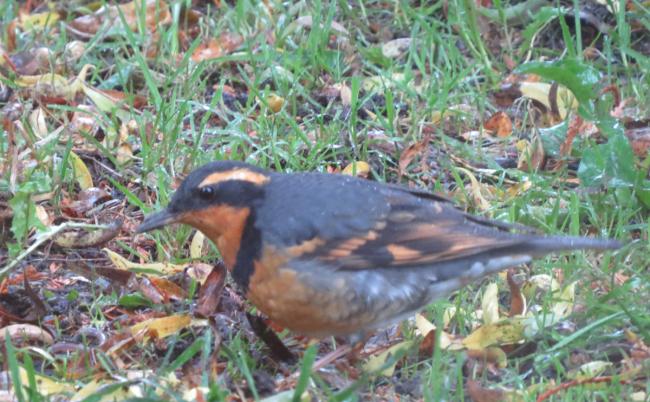At Large in Ballard: Flock to the future
Thu, 11/12/2015
By Peggy Sturdivant
My husband can’t hear birdsong anymore, but he can hear the sirens that are increasingly the soundtrack of Ballard life. His early years of working with heavy machinery damaged his hearing. What’s left for him is the Stellar Jay fighting off the crow, but not the Black-capped chickadee.
Growing up in a small fairly quiet town what used to strike me about cities was the sound of sirens from the streets below, night and day. I can still hear the birds in Ballard but Martin mostly hears sirens, float planes and leaf blowers.
.
So I’ve been thinking about density and increased noise as I scurry between planning meetings: 2016 Budget Committee at City Hall, project kick-off for Ballard Historical Society interactive mapping project, Sixth Annual Ballard Writers Collective on Friday the 13th. But with all my planning for this week and next year I haven’t made time for what should be the highest priority: planning for Seattle in 20 years.
It’s 2015, do you know about your Seattle 2035 Comprehensive Plan?
Citywide growth is a reality, but as a man said in public comment at the City of Seattle 2016 Budget Hearing, we need to stop letting growth control us. Livable Ballard pointed me to the Department of Building & Development’s website for this fact. Ballard has exceeded its targeted growth for 2005-2024 by 424%. And yes we do still have 19 years remaining, and no, there isn’t any cap on growth in the plan.
There are so many things we could say about that pace of growth, calculated in new net units, but it’s hard to know where to start. So I take a deep breath and channel Lillian Riley, founder of Groundswell NW, “You start where you can start.”
I think we are all so busy dealing with growing community needs: schools over capacity, cuts in services for the aging and people with disabilities, economic eviction (a.k.a. out of control rents), increased homelessness, development loopholes, overcrowded buses, or no buses…it goes on and on. We don’t have time or a sense that our voice will make any difference. Along with tree stewards like Diana Gardiner we have to fight so hard to save one tree at a time, an affordable apartment complex is insurmountable.
I’m trying to save one parcel of open space this week, how can I work on a plan for the future when the one we have is failing?
Over a cup of tea that was supposed to fortify me against land conservation despair I gazed out the glass door of my friend Laura’s kitchen. “Is that a purple finch?” I asked, suddenly focusing on the birding bedlam at her feeder. Then I twisted my head to study the nuthatch, upside down of course, on one of her cedar trees. There was veritable flock of chickadees and a sparrow so plump it looked like a robin. One spring we had to tiptoe in her yard because there was a nest by her porch.
When her house was built the land had been stripped of trees. In an old photo it looks like Kansas, surrounded only by corn stalks. Watching the birds over strong tea slowly calmed me; I let them do the flitting instead of me.
A newcomer arrived on the ground. “What’s that bird?” I asked. It wasn’t like any I had seen before, but was like many of them put together. Baltimore Oriole meets Bluebird meets Vireo-something.
“I don’t know,” Laura said.
The next day I heard a radio piece on birds and the need for biodiversity. Cutting to the point, if birds can’t survive someplace then it’s a matter of time before humans can’t either. But I learned about two good things. One of my fellow green space advocates discovered an orchard near a parking lot in the International District that dates to before World War II (and dispatched City Fruit to glean it). Then a Design Review board in West Seattle told the developer to resubmit a plan so as to save a cedar tree.
When I next saw Laura she’d identified the bird as a Varied Thrush. When I asked a neighbor for photos of her backyard birds she coincidentally sent me none other than the shy Varied Thrush she has only seen once. Her birding instructor has been hearing one for several weeks but not yet sighted one. This has inspired my birding friend to start a new Facebook group called “Ballard Birders.”
So what kind of city do I want to live in, now and in 2035? I want every citizen to be able to live in a city where bees can survive, fruit trees produce for 100 year and birds can nest in unexceptional cedar trees. I want to live in city that balances growth and conservation.
The Varied Thrush is usually only seen in Pacific Northwest forests. Either we’ve destroyed their habitat already or there’s hope for Ballard. Voice by voice. Bird by bird. I’m channeling Lillian Riley as we try to keep up with today, and plan for Seattle in 20 years. Repeat the words, “Varied Thrush.”
Draft plan and HALA proposal online at 2035.seattle.gov. Additional public meetings at 6 p.m. on 11.12 (West Seattle Senior Center) and at 9 a.m. on 11.14 (North Seattle College). Details at their website. Comments are due by 11.20.15 at 2035.seattle.gov or mail to Seattle DPD, Attn: Seattle 2035, 700 5th Avenue, Suite 2000, Seattle, WA 98124-4019. November 20th is an already extended deadline.


